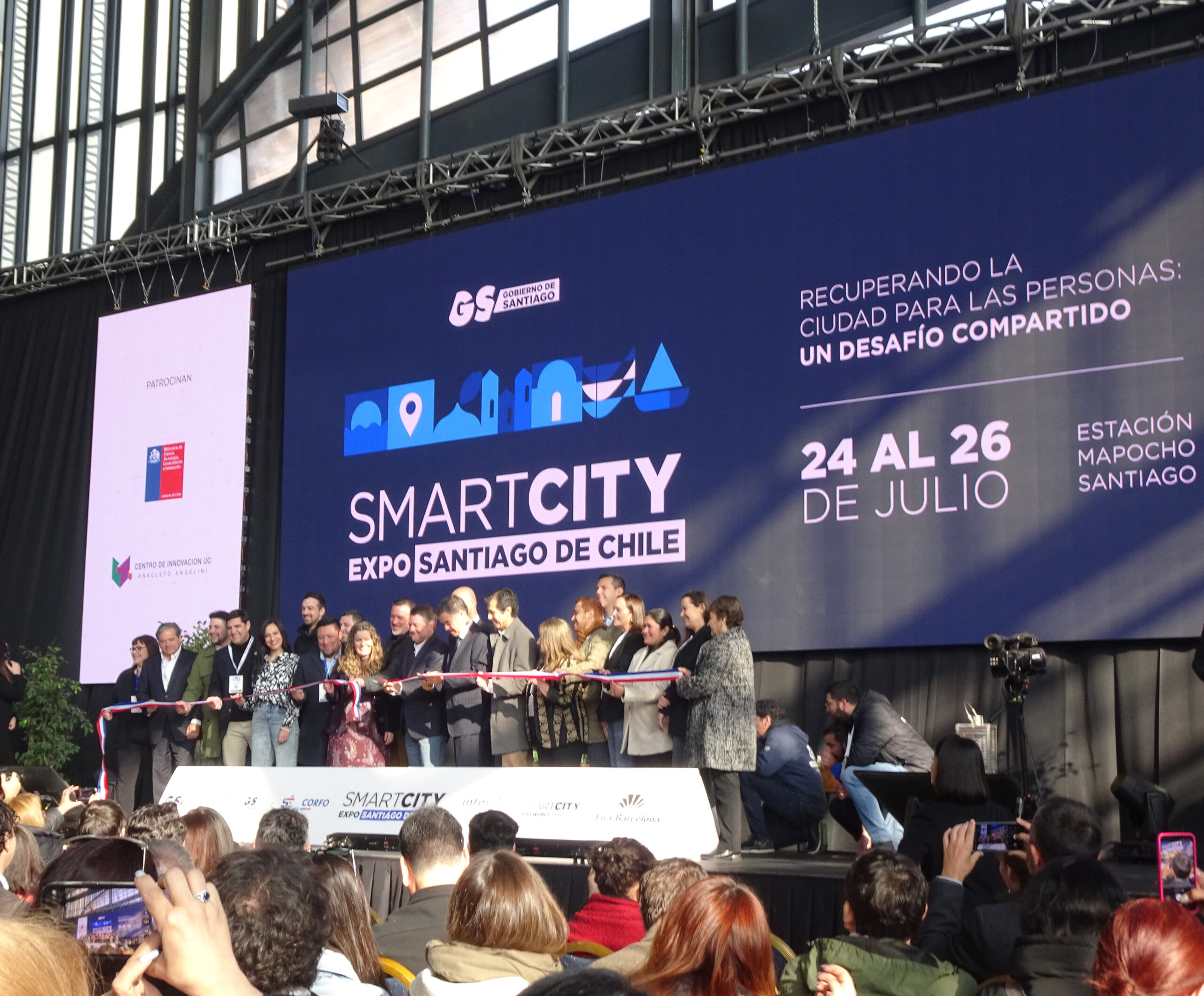Santiago, the capital and main city of Chile, and the Metropolitan Region, has been appointed as the smartest city in Latin America (LATAM) according to the IESE Cities in Motion Index (CIMI) 2025. This prestigious ranking is published annually by the Business School of the University of Navarra and evaluates cities worldwide based on various indicators such as governance, urban planning, technology, environment, social cohesion, and economy.
Santiago’s global high ranking (89th) is attributed to its advancements in mobility and transportation, including the integration of electric buses, effective governance, and strong economic performance. The city’s commitment to sustainability and innovation has also played a significant role in its recognition.
The Index comprises 9 dimensions and 113 indicators. The analysis was built around 183 cities, 92 countries, and 85 capitals. Those key dimensions of the CIMI 2025 include Economy, Governance, Environment, Mobility and Transportation, Urban Planning, International Profile and Technology, as well as Human Capital and Social Cohesion.
In 2025, the CIMI introduces significant changes to address the emerging challenges facing modern cities. The index has been updated with the elimination of indicators that lost relevance and has replaced them with others that better reflect the current trends. The modifications were made in areas such as economy, social cohesion, environment, technology and mobility and transportation.

Santiago, Chile (Photo: Adobe Stock)
What are the main factors that make Santiago the smartest city in Latin America?
Santiago stands out as a leading contender for the title of LATAM’s smartest city, thanks to its multifaceted approach to urban development. At its core, Santiago’s success stems from innovative governance strategies that prioritize transparency, citizen participation, and smart decision-making. The city excels in fostering sustainable environmental practices, emphasizing green spaces and renewable energy initiatives. Its mobility solutions are equally forward-thinking, with efficient public transportation systems and cutting-edge technology driving improvements in urban connectivity. Additionally, Santiago’s robust economy is bolstered by dynamic innovation and entrepreneurship ecosystems, creating opportunities for growth and technological advancement. Together, these factors position Santiago as a shining example of how integrated planning and commitment to progress can transform a city into a hub of intelligence and sustainability.
Governance
Santiago has implemented policies, creating the adequate framework that prioritizes sustainability and urban development, ensuring efficient management of resources and services. Chile’s carbon neutrality commitment by 2050 lays the foundation for long-term resilience and inclusivity.
The “SE Santiago Smart City Program,” launched in 2016, is a strategic initiative by the Metropolitan Regional Government and CORFO (Chile’s Economic Development Agency). Its primary goal is to transform Santiago into a smarter, more sustainable city by leveraging technology and innovation. To create an integrated and efficient urban ecosystem, collaboration among municipalities, citizens, and private sector stakeholders is emphasized.
“Plan Santiago 2050” is an ambitious initiative designed to transform Santiago into a sustainable, equitable, and integrated city-region by mid-century. Launched in 2022, the plan emphasizes reducing urban segregation, promoting equitable development across neighborhoods, and combating environmental challenges like desertification and water scarcity. It also envisions improved infrastructure and mobility solutions to enhance connectivity and accessibility for communities. Notably, the plan encourages active citizen participation through thematic workshops and communal discussions, ensuring that residents have a voice in shaping their city’s future. This forward-thinking strategy aims to create a resilient and inclusive Santiago for generations to come.
The “Regional Strategy for the Metropolitan Region 2024-2035” is a development plan for the Metropolitan Region of Santiago. It serves as a guiding framework for regional planning and management, addressing key areas such as territorial equity, environmental sustainability, and economic growth. The strategy emphasizes collaboration among municipalities, public services, and private sectors to achieve long-term goals. It also includes citizen participation to ensure that the initiatives align with the needs and aspirations of the community.
Economy
In recent decades, Chile has stood out as one of the most successful countries in LATAM in terms of achieving economic growth and reducing poverty, according to the World Bank’s 2022 report. Since 1990, Chile’s per capita GDP has seen a significant increase of over 300% (World Bank, 2023), accompanied by a substantial decline in the proportion of inhabitants living below the income poverty line, from 69% in 1990 to 8.6% in 2017 (MIDESO, 2017).
The Santiago Metropolitan Region, which accounts for 40% of the national population, has evolved into the country’s primary financial and commercial hub, exemplifying these changes most notably. This strong economic performance can be attributed to the driving forces of innovation and entrepreneurship. Santiago’s economic performance is closely linked to its innovative and entrepreneurial ecosystem, which is supported by initiatives such as Start-Up Chile, a seed accelerator program created by the Chilean government in 2010, promoting innovation and growth. Santiago has recently been ranked among the top 50 global cities for artificial intelligence (AI) startup development. Santiago ranks 48th globally for AI-focused startups, according to a report by StartupBlink (*), and is one of only two LATAM cities on the list, alongside Sao Paulo, Brazil.
The “100 Solutions for Santiago” is a collaborative effort between the SE Santiago program, CORFO Metropolitano and the Regional Development Corporation of Santiago, highlighting the city’s commitment to sustainable urban development and technological innovation. The initiative was launched during the Smart City Expo Santiago 2024 showcasing over 100 innovative projects developed by companies and entrepreneurs from the Metropolitan Region, as well as hubs, incubators, and institutions. (See our article: “Innovating Santiago: 100 Solutions for a Smarter City” dated 08/20/2024).
Carbon Neutrality
Santiago’s efforts align with Chile’s pledge to achieve carbon neutrality by 2050, showcasing its commitment to combating climate change. Santiago’s commitment to achieving carbon neutrality by 2050 is outlined in Chile’s Long-Term Climate Strategy, which serves as a roadmap for the entire country, including Santiago, to transition to a low-emission and climate-resilient economy. It includes 407 specific measures across various sectors to meet this ambitious goal. Additionally, the updated Nationally Determined Contribution, submitted to the United Nations Framework Convention on Climate Change, reinforces this commitment and sets intermediate targets for reducing greenhouse gas emissions.
Mobility and Transportation
To achieve 100% electrification of its public transport fleet by 2035, the city has made significant advancements in public transportation, including integrating the largest fleet of electric buses outside China, with over 2,400 vehicles featuring modern amenities like wi-fi, USB chargers, and universal accessibility, thereby improving mobility and reducing pollution substantially. It has become a leader in sustainable public transportation in LATAM. To support its electric fleet, a robust network of charging stations needs to be developed. This transition has been supported by a public-private partnership and the development of charging infrastructure.
Micro and Sustainable Mobility
The city has made significant strides in promoting eco-friendly commuting by expanding its bike lane network and introducing public bike-sharing systems. For instance, ‘The Nueva Alameda Project’ in Santiago, is a transformative urban initiative that aims to revitalize the city’s main axis, Alameda-Providencia. This project aims to enhance public spaces, boost mobility, and promote sustainable development. The plan involves creating new green spaces, building a comprehensive bike lane network across the city, and revamping iconic areas like Plaza Italia (Plaza Baquedano) to prioritize pedestrian-friendly and accessible design, with a focus on walkability in various neighborhoods.
Technology
By embracing technology, we can enhance urban living through smart infrastructure and digital services. Santiago integrates advanced technologies into its urban planning, enhancing connectivity and accessibility for its residents. The Digital Agenda 2028 is an ambitious initiative aimed at fostering inter-municipal collaboration and leveraging technology to improve urban management and quality of life. The agenda emphasizes cooperation among municipalities such as Lo Barnechea and Las Condes: shared strategies, communication frameworks and joint initiatives to address urban challenges, focusing on empowering citizens to participate actively in city management, enhancing transparency, reducing costs and minimizing environmental impacts.
Waste Management
Santiago has implemented comprehensive waste management systems, including recycling programs and initiatives to reduce illegal waste disposal. The city is part of the Urban Ocean Program, which champions circular economy principles and addresses challenges like plastic leakage and greenhouse gas emissions.
Green Spaces
The initiative of the electrification of public transport has contributed to a significant reduction in air pollution and noise levels, improving the quality of life for residents. Efforts to combat air pollution, especially during the winter months, are central to Santiago’s environmental strategies and the city’s strong commitment to create and improve green spaces for the well-being and quality of life of residents. As part of the green space’s strategy, the Parque de las Américas in Conchalí commune, Santiago, is currently under construction. The project began with the laying of the first stone in August 2024. This ambitious initiative aims to transform a previously neglected area into a vibrant green space spanning over 44,000 square meters. The park will feature an amphitheater, water play areas, a skate park, pergolas, and sports zones. It also incorporates sustainable practices, such as water-efficient irrigation systems and the planting of low-water-consumption trees.
Renewable Energy and Efficiency
Chile is leading the way in renewable energy, and Santiago is playing a pivotal role in achieving the country’s bold sustainability objectives. Chile, particularly Santiago, enjoys an abundance of solar radiation and consistent wind patterns, making it an ideal location for solar and wind energy. Solar farms and wind turbines have been harnessed to generate clean energy from these natural resources, playing a crucial role. Chile aims to become a global leader in green hydrogen production, and Santiago is a key part of this broader strategy. This process utilizes renewable energy to generate hydrogen, providing a cleaner alternative fuel source. By 2030, Chile plans to derive 80% of its energy from renewable sources, with Santiago serving as a key hub for executing these ambitious initiatives. The collaboration between the government and private sector has boosted the adoption of renewable energy technologies, such as the installation of solar panels on public buildings and metro stations.
Social Cohesion
Ensure that the city’s development benefits all residents by prioritizing social inclusion and community engagement. Santiago promotes inclusivity and social equity by reducing commute times for low-income residents and linking outlying areas to the city center. Essential public services like education, healthcare, and transportation are often inaccessible to low-income groups. Steps are being taken to increase access to these services in outlying areas. Programs like “The Right and Dignity Program” concentrate on addressing housing struggles, advocating for dignified living conditions for low-income residents, and enabling them to stay in their original neighborhoods while accessing improved urban services.
Santiago stands proudly as a shining example of innovation and sustainability, solidifying its position as the smartest city in LATAM. From transformative governance and cutting-edge technology to equitable social policies and eco-conscious urban planning, the city’s achievements reflect an unwavering commitment to enhancing the quality of life for all its residents.
(*) StartupBlink is a global innovation economy research platform, that provides public sector ecosystem developers, corporate startup programs, multilateral organizations, and researchers with the knowledge and tools to map, brand, and accelerate innovation.
Resources
Common challenges, similar responses: the world’s leading cities converge on strategy | IESE Insight
IESE Cities in Motion Index 2025 ST-0665-E



